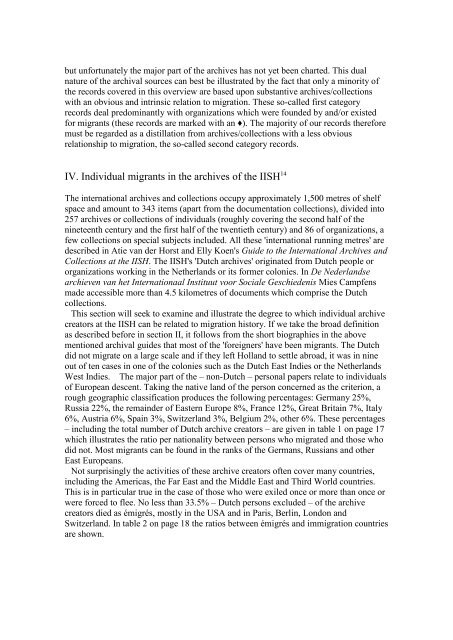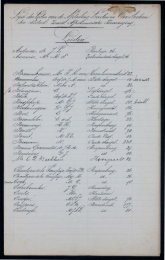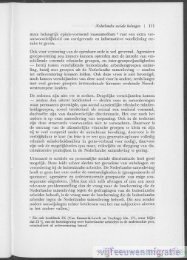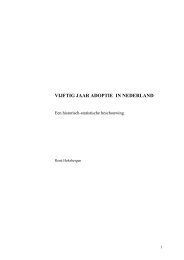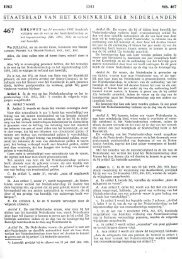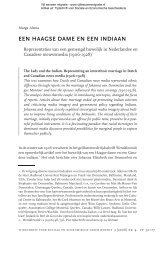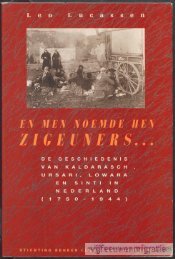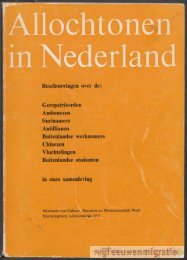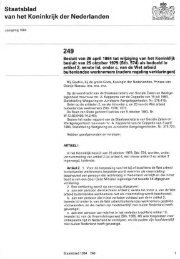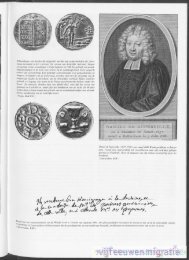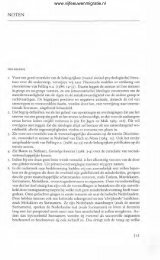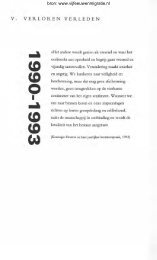however that American society can still be seen as an exception to <strong>the</strong> rule because <strong>the</strong>streams <strong>of</strong> migrants <strong>the</strong> young nation has had to accommodate are relatively recent, vast<strong>and</strong> miscellaneous.This approach simplified <strong>the</strong> selection <strong>of</strong> material, especially with regard to <strong>the</strong>criteria on which Jewish organizations should be considered. On <strong>the</strong>se grounds wefound it legitimate to include all manner <strong>of</strong> archival material on Jewish-Americanorganizations in <strong>the</strong> USA, while Jewish organizations in Europe are only included if<strong>the</strong>y had a demonstrable relationship to migration. This tw<strong>of</strong>old approach may beillustrated as follows. In consequence <strong>of</strong> <strong>the</strong> simple fact that <strong>the</strong> history <strong>of</strong> Americanimmigration is shorter compared to that <strong>of</strong> Europe, archival materials regarding <strong>the</strong>Jüdische Volkszeitung, a Jewish newspaper published in Vienna is not included, whilethose <strong>concerning</strong> <strong>the</strong> Jewish American anarchist newspaper The Fraye Arbeter Shtimepublished in New York can be found in <strong>the</strong> survey.On account <strong>of</strong> <strong>the</strong> broad sweep <strong>of</strong> <strong>the</strong> perspective employed, this guide, in spite <strong>of</strong> anumber <strong>of</strong> constraints, gives an insight into a wide range <strong>of</strong> subjects; within <strong>the</strong> IISHholdings we have uncovered several different kinds <strong>and</strong> aspects <strong>of</strong> migration.III. Justification <strong>and</strong> elucidation <strong>of</strong> <strong>the</strong> contents <strong>of</strong> this surveyOwing to <strong>the</strong> limited time available <strong>and</strong> <strong>the</strong> nature <strong>of</strong> <strong>the</strong> series in which this guide ispublished, 11 <strong>the</strong> material covered is a mere fraction <strong>of</strong> what <strong>the</strong> IISH has in its collectionon migration <strong>and</strong> related subjects. As pointed out before, this overview is basedprimarily on archival sources. The 500,000 books <strong>and</strong> pamphlets contained in <strong>the</strong> IISH'scatalogs, 12 <strong>the</strong> 60,000 periodicals, <strong>the</strong> collections <strong>of</strong> documentation <strong>and</strong> <strong>the</strong> wide variety<strong>of</strong> audio-visual material were scarcely consulted at all, but <strong>the</strong>se undoubtedly contain alot more on migration. This can be illustrated for example by <strong>the</strong> 'little excursion' wemade to <strong>the</strong> periodicals collection in chapter C. In this section we examined whe<strong>the</strong>r <strong>the</strong>émigré journals encountered in <strong>the</strong> archives 13 were also available as actual numbers in<strong>the</strong> IISH periodicals collection. The result exceeded all expectation. Not only were most<strong>of</strong> <strong>the</strong> journals found in <strong>the</strong> archives covered by one, more or even all volumespublished, but an impressive number <strong>of</strong> o<strong>the</strong>r émigré journals also came to light. For <strong>the</strong>purposes <strong>of</strong> this overview we decided only to make mention <strong>of</strong> <strong>the</strong> periodicalscollection where a particular newspaper had a significant position in <strong>the</strong> archives, e.g.<strong>the</strong> paper <strong>of</strong> <strong>the</strong> Italian-American anarchist movement L'Adunata dei refrattari <strong>and</strong> <strong>the</strong>German 'Exil-Zeitung' Deutsche Brüsseler Zeitung. Since both newspapers werefrequently found in certain archival holdings, we thought it prudent to check whe<strong>the</strong>r<strong>the</strong> IISH periodicals collection also held some editions. This indeed appeared to becorrect; several volumes <strong>of</strong> <strong>the</strong> two newspapers in question <strong>and</strong> many o<strong>the</strong>r papers werediscovered. Thus, although we refer to this collection only incidentally, it is worthwileto stress <strong>the</strong> internationally unique <strong>and</strong> important position <strong>of</strong> <strong>the</strong> IISH in this field. (See<strong>the</strong> appendix on pages 139-140 for a list <strong>of</strong> bibliographies <strong>concerning</strong> <strong>the</strong> émigré-press)Besides <strong>the</strong> practical reasons mentioned earlier <strong>the</strong>re was a more substantial reason forconcentrating principally on archival sources. If we make a comparison between <strong>the</strong>archives <strong>and</strong> <strong>the</strong> o<strong>the</strong>r sources mentioned, <strong>the</strong> latter – in most cases – speak for<strong>the</strong>mselves, while <strong>the</strong> archives – despite excellent descriptions – always contain morethan might be thought at first sight. Where possible one can consult inventories or lists
ut unfortunately <strong>the</strong> major part <strong>of</strong> <strong>the</strong> archives has not yet been charted. This dualnature <strong>of</strong> <strong>the</strong> archival sources can best be illustrated by <strong>the</strong> fact that only a minority <strong>of</strong><strong>the</strong> records covered in this overview are based upon substantive archives/collectionswith an obvious <strong>and</strong> intrinsic relation to migration. These so-called first categoryrecords deal predominantly with organizations which were founded by <strong>and</strong>/or existedfor migrants (<strong>the</strong>se records are marked with an ♦). The majority <strong>of</strong> our records <strong>the</strong>reforemust be regarded as a distillation from archives/collections with a less obviousrelationship to migration, <strong>the</strong> so-called second category records.IV. Individual migrants in <strong>the</strong> archives <strong>of</strong> <strong>the</strong> IISH 14The international archives <strong>and</strong> collections occupy approximately 1,500 metres <strong>of</strong> shelfspace <strong>and</strong> amount to 343 items (apart from <strong>the</strong> documentation collections), divided into257 archives or collections <strong>of</strong> individuals (roughly covering <strong>the</strong> second half <strong>of</strong> <strong>the</strong>nineteenth century <strong>and</strong> <strong>the</strong> first half <strong>of</strong> <strong>the</strong> twentieth century) <strong>and</strong> 86 <strong>of</strong> organizations, afew collections on special subjects included. All <strong>the</strong>se 'international running metres' aredescribed in Atie van der Horst <strong>and</strong> Elly Koen's Guide to <strong>the</strong> International Archives <strong>and</strong>Collections at <strong>the</strong> IISH. The IISH's 'Dutch archives' originated from Dutch people ororganizations working in <strong>the</strong> Ne<strong>the</strong>rl<strong>and</strong>s or its former colonies. In De Nederl<strong>and</strong>searchieven van het Internationaal Instituut voor Sociale Geschiedenis Mies Campfensmade accessible more than 4.5 kilometres <strong>of</strong> documents which comprise <strong>the</strong> Dutchcollections.This section will seek to examine <strong>and</strong> illustrate <strong>the</strong> degree to which individual archivecreators at <strong>the</strong> IISH can be related to migration history. If we take <strong>the</strong> broad definitionas described before in section II, it follows from <strong>the</strong> short biographies in <strong>the</strong> abovementioned archival guides that most <strong>of</strong> <strong>the</strong> 'foreigners' have been migrants. The Dutchdid not migrate on a large scale <strong>and</strong> if <strong>the</strong>y left Holl<strong>and</strong> to settle abroad, it was in nineout <strong>of</strong> ten cases in one <strong>of</strong> <strong>the</strong> colonies such as <strong>the</strong> Dutch East Indies or <strong>the</strong> Ne<strong>the</strong>rl<strong>and</strong>sWest Indies. The major part <strong>of</strong> <strong>the</strong> – non-Dutch – personal papers relate to individuals<strong>of</strong> European descent. Taking <strong>the</strong> native l<strong>and</strong> <strong>of</strong> <strong>the</strong> person concerned as <strong>the</strong> criterion, arough geographic classification produces <strong>the</strong> following percentages: Germany 25%,Russia 22%, <strong>the</strong> remainder <strong>of</strong> Eastern Europe 8%, France 12%, Great Britain 7%, Italy6%, Austria 6%, Spain 3%, Switzerl<strong>and</strong> 3%, Belgium 2%, o<strong>the</strong>r 6%. These percentages– including <strong>the</strong> total number <strong>of</strong> Dutch archive creators – are given in table 1 on page 17which illustrates <strong>the</strong> ratio per nationality between persons who migrated <strong>and</strong> those whodid not. Most migrants can be found in <strong>the</strong> ranks <strong>of</strong> <strong>the</strong> Germans, Russians <strong>and</strong> o<strong>the</strong>rEast Europeans.Not surprisingly <strong>the</strong> activities <strong>of</strong> <strong>the</strong>se archive creators <strong>of</strong>ten cover many countries,including <strong>the</strong> Americas, <strong>the</strong> Far East <strong>and</strong> <strong>the</strong> Middle East <strong>and</strong> Third World countries.This is in particular true in <strong>the</strong> case <strong>of</strong> those who were exiled once or more than once orwere forced to flee. No less than 33.5% – Dutch persons excluded – <strong>of</strong> <strong>the</strong> archivecreators died as émigrés, mostly in <strong>the</strong> USA <strong>and</strong> in Paris, Berlin, London <strong>and</strong>Switzerl<strong>and</strong>. In table 2 on page 18 <strong>the</strong> ratios between émigrés <strong>and</strong> immigration countriesare shown.
- Page 1: SURVEY OF THE ARCHIVAL SOURCESCONCE
- Page 8 and 9: F.6. CZECHS .......................
- Page 11: migration and settlement, we decide
- Page 15 and 16: In addition to the explanation of c
- Page 17 and 18: TABLE.1.Total of the individual arc
- Page 19: Notes1. This congress , held on 17
- Page 23 and 24: A. POLITICAL ORGANIZATIONS BY AND F
- Page 25 and 26: Ungarische Sozialdemokratische Arbe
- Page 27 and 28: Berlinskij Klub im. Martova ♦(Men
- Page 31 and 32: A.6. ITALYConcentrazione di Azioni
- Page 33 and 34: exterior'(propaganda secretary and
- Page 35 and 36: B. NON-POLITICAL ORGANIZATIONS BY A
- Page 37 and 38: CONTENTS/INV. NR.: (28) Xerox copy
- Page 39 and 40: SOURCE: ACCR ARCHIVEENTRY: LISTSIZE
- Page 41 and 42: B.7. GERMANYArbeitsausschuss freige
- Page 43 and 44: (See F.11. GERMANS/Schlüter, F.H.
- Page 45 and 46: mentioned below.(See F.9. FRENCH/Br
- Page 47 and 48: C. EDITORIAL ACTIVITIES BY AND FOR
- Page 49 and 50: Bulletin Russe (Lausanne)SOURCE: PE
- Page 51 and 52: ENTRY: INVENTORYINFO.: The PSR surv
- Page 53 and 54: C.6. GERMANYArbeiter-Zeitung (New Y
- Page 55 and 56: INFO.: This newspaper had a sunday
- Page 57 and 58: INFO.: FAS 1890-1977, leading and l
- Page 59 and 60: Commissie voor Huisvesting van Spaa
- Page 61 and 62: Committee, as a way of co-operation
- Page 63 and 64:
Neu Beginnen and German emigrants i
- Page 65 and 66:
PERIOD: 1940, 1945CONTENTS/INV. NR.
- Page 67 and 68:
Documentation de Statistique Social
- Page 69 and 70:
correspondence, financial pieces.An
- Page 71 and 72:
E. INTERNATIONAL ORGANIZATIONS AND
- Page 73 and 74:
CONTENTS: Among other things: from
- Page 75 and 76:
CONTENTS: (spread over this survey)
- Page 77 and 78:
E.2.c. IFTUIFTU-aid to refugeesSOUR
- Page 79 and 80:
CONTENTS/INV. NR.: (2764) Report on
- Page 81 and 82:
E.3.d. SAISAI - Bulgarian borderpeo
- Page 83 and 84:
E.3.e. WRIWRI - DuchoborySOURCE: WR
- Page 85 and 86:
Danneberg, Robert (1885-1942)SOURCE
- Page 87 and 88:
(made propaganda trips to Germany,
- Page 89 and 90:
Masaryk, Tomás G. (1850-1937) and
- Page 91 and 92:
Netherlands with documentation arou
- Page 93 and 94:
Kramers, Johannes H. (1891-1951)SOU
- Page 95 and 96:
come to the Netherlands after all),
- Page 97 and 98:
Wiardi Beckman, Herman B. ('Stuuf')
- Page 99 and 100:
Cabet, Etienne (1788-1856)SOURCE: P
- Page 101 and 102:
MIGRATION: Paris, Spain (Civil War)
- Page 103 and 104:
MIGRATION: Cologne, died in Vienna
- Page 105 and 106:
SOURCE: PERS. ARCHIVEENTRY: INVENTO
- Page 107 and 108:
Liebknecht, Theodor (1870-1948)SOUR
- Page 109 and 110:
INFO.: Took part in various efforts
- Page 111 and 112:
SOURCE: PERS. ARCHIVEENTRY: LISTMIG
- Page 113 and 114:
concerning (...) votes for blacks.W
- Page 115 and 116:
SOURCE: PERS. ARCHIVEMIGRATION: 191
- Page 117 and 118:
SOURCE: PERS. ARCHIVEMIGRATION: Pes
- Page 119 and 120:
SOURCE: PERS. ARCHIVEENTRY: LISTMIG
- Page 121 and 122:
F.22. RUSSIANSAbramovic, Rafail A.
- Page 123 and 124:
ENTRY: LISTMIGRATION: Odessa (prese
- Page 125 and 126:
MIGRATION: Living in Paris until 19
- Page 127 and 128:
MIGRATION: Bekovo, 1909 left Russia
- Page 129 and 130:
Sullerzickij, L.A.SOURCE: Duchobory
- Page 131 and 132:
(1093) Papers of the late M. Pomera
- Page 133 and 134:
Clara Thalmann-Ensner: BaselThalman
- Page 135 and 136:
Poem written by migrantsSOURCE: SAI
- Page 137:
Race Chaos and the Jewish Danger by
- Page 140:
Emigré journals published in the N


